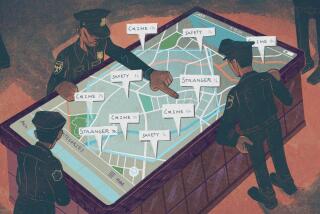Technology Helps Put Surveillance in Focus
- Share via
BOSTON — Like so many Americans, Steve Hill was appalled when he saw newspaper reprints of two World Trade Center terrorists as they passed through airport security the morning of Sept. 11.
The sight of Mohamed Atta and Waleed M. Alshehri as captured on a video camera in Portland, Maine, was shocking enough. But Hill had another, deeply visceral reaction.
“Professional pride,” he explained. “I saw these rotten-looking images in the newspaper, and thought, ‘We can do better.’ ”
So he called the Boston FBI and offered to install--for free--his company’s software that clarifies visual images. Salient Stills is a small start-up, and when shareholders and directors winced at about $20,000 worth of corporate altruism, Hill reminded them that, since the Sept. 11 attacks, Americans have opened their hearts and their pocketbooks. Hill figured Salient could at least pony up their pixels.
“So many people in the country right now are feeling, ‘I could go beat up those terrorists,’ ” Hill said. “It was sort of the same idea.”
The weapon the 10-person enterprise supplied the local FBI is a technique for clarifying moving images from videotape. Reproduced as still photographs, video images tend to be grainy. Subtleties vanish. Facial features and details such as license plate imprints are hard to distinguish.
“Many years ago”--in 1990, Laura Teodosio said--the challenge of transforming a moving medium into a still image with precise resolution became the subject of her master’s thesis at MIT. Working at the university’s famed Media Lab--where advanced technology finds practical applications--Teodosio developed a software system she called videoFOCUS. Its purpose was “temporal condensation,” essentially squeezing a series of moving images into a legible print.
Her signature effort was a glorious portrait of cellist Yo-Yo Ma, sawing away at a concert, yet absolutely still in Teodosio’s finished image. She also produced a clear likeness of pitcher Roger Clemens with his legendary fastball streaming sequentially overhead. Neither endeavor seemed destined for widespread appreciation.
“But as it turned out, there was a side effect,” said Teodosio, 37. “We wound up getting video frames that were higher quality than the original.”
The 3-year-old company’s name was taken from Teodosio’s thesis, which posited that “you take the salient features from each frame” to create a more cohesive image.
Newspapers were Salient’s first target audience. Teodosio’s product was born under the aegis of a group called “news and the future,” MIT techies seeking novel avenues to interact with news information.
Though USA Today and the New York Times snapped up a Salient system that enhanced the translation of video images to still photos, others were uncomfortable because the process involves combining pixels--tiny dots that make up any image on film or videotape--from several sequential frames. The word “composite” strikes fear in the souls of media purists.
But Salient CEO Hill, a 52-year-old former book publisher, persevered, noting that “every camera is moving, even if it is affixed to a tripod.” His firm’s technology--in use on a trial basis at the Los Angeles Times--captures common information from consecutive frames and “basically cleans up the dust,” he said.
From news environments Salient made an unexpected transition into the world of security, Hill said. Every day, he said, most Americans unknowingly are videotaped a dozen times or more. Video cameras whir at banks, rental car agencies, convenience stores and, of course, airports.
But many mothers would not recognize their own children from the soupy images that result. The video cameras function mainly as deterrents, Hill said.
Late in June, however, the video system in a Boston pharmacy recorded a prescription drug theft. The incident, one in a series of synthetic opiate robberies that have plagued the area in recent months, received wide attention. Hill contacted the Boston police and offered to help refine the blurry images of the man seen stealing OxyContin, a powerful painkiller.
A spokesman for Police Commissioner Paul Evans confirmed that the department is using the Salient technology. Hill said his company also has sold the process to the Singapore defense force, and to the Carabinieri, Italy’s paramilitary national police force.
Boston FBI spokeswoman Gail Marcinkiewicz would not comment about whether the Salient technology is in use at headquarters here.
But at Salient--a “little private company” valued at $12 million to $15 million--Hill said the decision to help what he playfully called “an unnamed federal agency” stemmed from President Bush’s entreaty to all Americans to aid in the investigation of the attacks. That plea, Hill said, may have had special resonance in Boston, where terrorists boarded the two planes that crashed into the twin towers.
“I definitely think we’re feeling real guilt here,” he said. “We let them through. They were hanging around here. They figured it was easy pickings here, and they were right.”
The Portland airport security video is almost incidental to the investigation at this point, Hill said. Both terrorists are dead.
“But they have a lot of different images of a lot of different things. There’s a lot going on. I can say this: The federal agency is devoting an enormous amount of resources to this process.”






